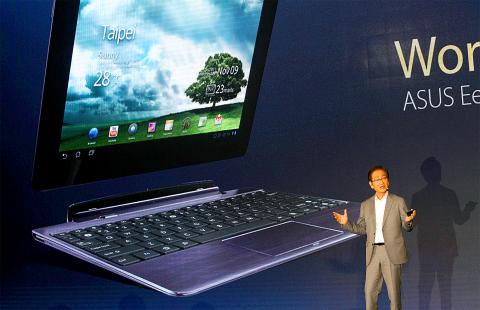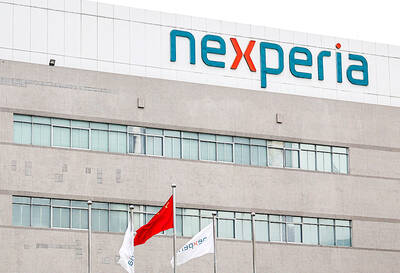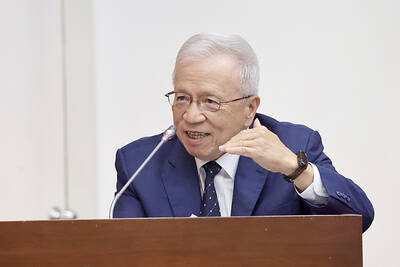Asustek Computer Inc (華碩), the world’s fourth-largest PC vendor by shipments, might be entering one of its toughest operating periods this year after its ambition to branch out into multiple areas backfired and its core businesses face industry headwinds.
The company’s performance might hit a trough this quarter, after it last quarter posted its lowest net income in 23 quarters at NT$3.65 billion (US$121.18 million).
Asustek CEO Jerry Shen (沈振來) on May 11 attributed the decline to appreciation of the New Taiwan dollar; rising component costs for notebook computers and smartphones; and a product transition ahead of a new smartphone launch.

Photo: Chiang Ying-ying, AP
However, the company’s challenges are much bigger than that.
On May 8, Asustek chief operating officer and board member S.Y. Hsu (許先越) tendered his resignation to Shen, chairman Jonney Shih (施崇棠) and chief strategy officer Ted Hsu (徐世昌) via e-mail after more than 20 years at the company.
S.Y. Hsu played a major role in promoting Asustek’s first Eee PC in 2007, which helped the company significantly expand its global market share.
He was also the key player pushing the company’s Zenbook series of notebook computers over the past few years.
Despite S.Y. Hsu avoiding the spotlight since May 8, local media have reported that he resigned after failing to persuade the firm’s management to allocate more resources to his team — including research and development and marketing funding — from the smartphone business.
There has also been speculation about an internal power struggle in the company’s management.
However, Asustek has obviously made significant efforts to keep S.Y. Hsu on board, as he was named one of the key figures to lead the company’s latest restructuring program, which was announced on Friday.
In his new role overseeing both the notebook and desktop PC businesses, S.Y. Hsu is to have more resources and operational power, Asustek said, but added that there is no truth to rumors that an internal power struggle, an imbalance in resource allocations to different business units, or both, had anything to do with his resignation.
Over the past three years, Asustek has ambitiously branched out into various fields, including tablets, smartphones, virtual reality, augmented reality, robotics and artificial intelligence. The company over the past two years allocated more resources to the smartphone segment in a bid to grow handset revenue to above that of notebook’s by next year.
However, none of the new businesses, including smartphones, have eked out stable profits thus far. Moreover, by adding to its motherboard, desktop and notebook segments, the company has stretched its resources thin — in terms of limited capacity for engineers and research and development, while marketing and purchasing managers have been required to juggle several fields at the same time.
Asustek’s strategy of developing its non-PC businesses is correct, as the PC industry has been in decline for years, but it is questionable whether it was wise to extend its reach to so many fields simultaneously while its resources remain limited.
Asustek spokesman Nick Wu (吳長榮) said the company has high hopes that the latest corporate restructuring will optimize its resources and revitalize its momentum.
However, he might be overly optimistic, as a number of key figures remain in the dark about their future roles and the challenges for their tasks.
For instance, Chang Rangoon (張仰光), who previously headed the tablet team and has been named to lead a new gaming business unit as part of the restructuring, on Monday said that he did not know the details of his new operational scope or how many employees his new business unit would have.
“A lot of things have not been finalized. Jerry [Shen] and I have to discuss it,” Chang said on the sidelines of a pre-Computex news conference.
It remains to be seen if Asustek’s corporate restructuring will work in the long term, but concerns linger about the company’s decisionmaking and strategic planning, which could overshadow its performance in the remainder of the year.

JITTERS: Nexperia has a 20 percent market share for chips powering simpler features such as window controls, and changing supply chains could take years European carmakers are looking into ways to scratch components made with parts from China, spooked by deepening geopolitical spats playing out through chipmaker Nexperia BV and Beijing’s export controls on rare earths. To protect operations from trade ructions, several automakers are pushing major suppliers to find permanent alternatives to Chinese semiconductors, people familiar with the matter said. The industry is considering broader changes to its supply chain to adapt to shifting geopolitics, Europe’s main suppliers lobby CLEPA head Matthias Zink said. “We had some indications already — questions like: ‘How can you supply me without this dependency on China?’” Zink, who also

At least US$50 million for the freedom of an Emirati sheikh: That is the king’s ransom paid two weeks ago to militants linked to al-Qaeda who are pushing to topple the Malian government and impose Islamic law. Alongside a crippling fuel blockade, the Group for the Support of Islam and Muslims (JNIM) has made kidnapping wealthy foreigners for a ransom a pillar of its strategy of “economic jihad.” Its goal: Oust the junta, which has struggled to contain Mali’s decade-long insurgency since taking power following back-to-back coups in 2020 and 2021, by scaring away investors and paralyzing the west African country’s economy.

Taiwan Semiconductor Manufacturing Co (TSMC, 台積電) received about NT$147 billion (US$4.71 billion) in subsidies from the US, Japanese, German and Chinese governments over the past two years for its global expansion. Financial data compiled by the world’s largest contract chipmaker showed the company secured NT$4.77 billion in subsidies from the governments in the third quarter, bringing the total for the first three quarters of the year to about NT$71.9 billion. Along with the NT$75.16 billion in financial aid TSMC received last year, the chipmaker obtained NT$147 billion in subsidies in almost two years, the data showed. The subsidies received by its subsidiaries —

BUST FEARS: While a KMT legislator asked if an AI bubble could affect Taiwan, the DGBAS minister said the sector appears on track to continue growing The local property market has cooled down moderately following a series of credit control measures designed to contain speculation, the central bank said yesterday, while remaining tight-lipped about potential rule relaxations. Lawmakers in a meeting of the legislature’s Finance Committee voiced concerns to central bank officials that the credit control measures have adversely affected the government’s tax income and small and medium-sized property developers, with limited positive effects. Housing prices have been climbing since 2016, even when the central bank imposed its first set of control measures in 2020, Chinese Nationalist Party (KMT) Legislator Lo Ting-wei (羅廷瑋) said. “Since the second half of